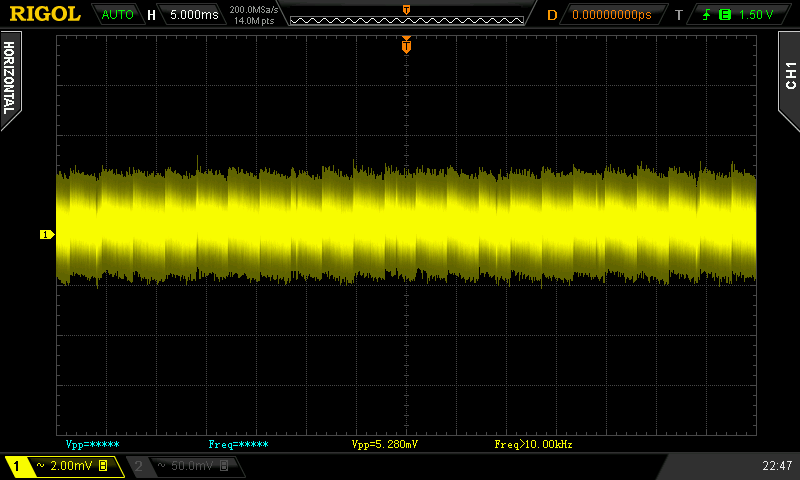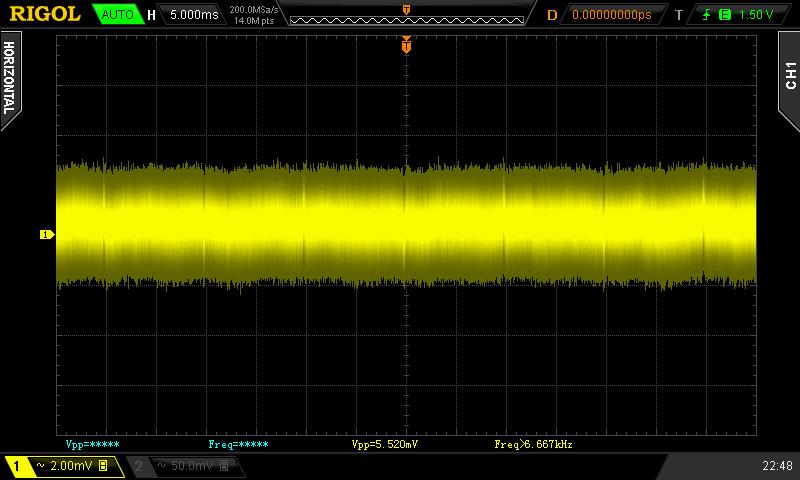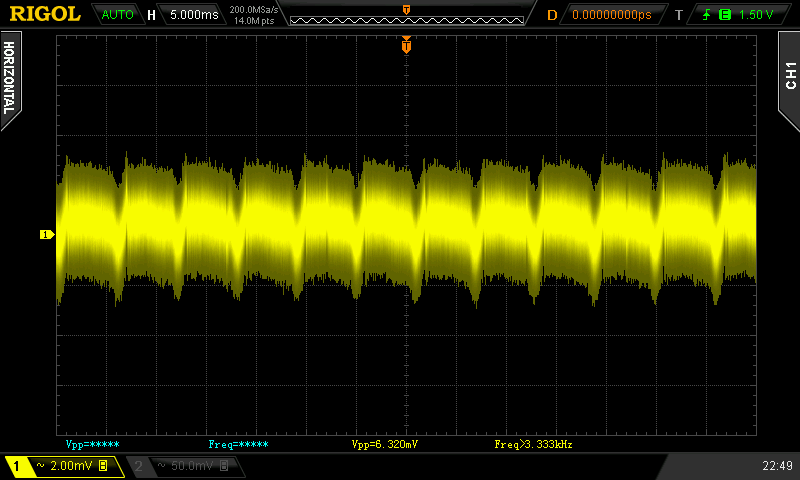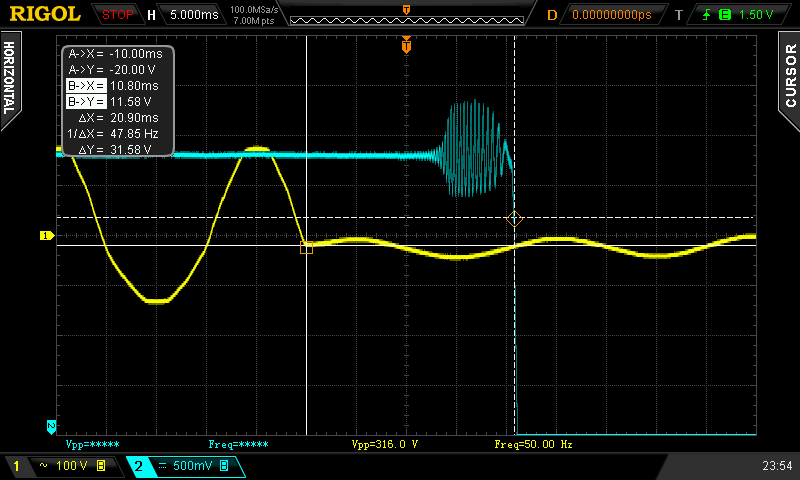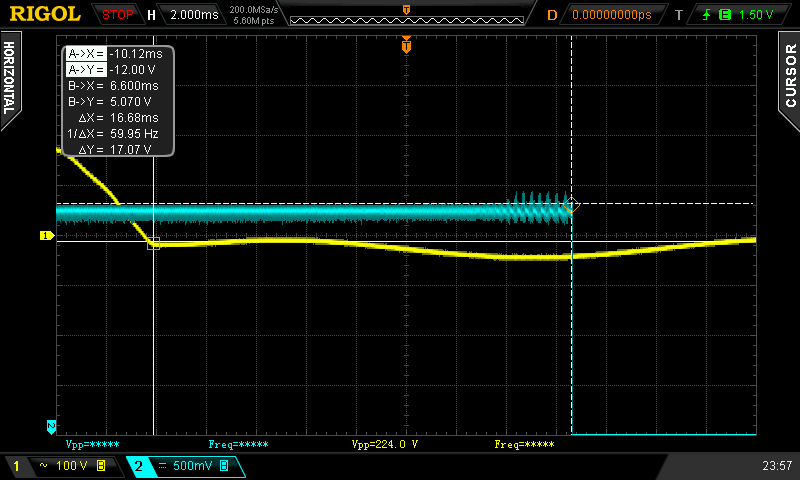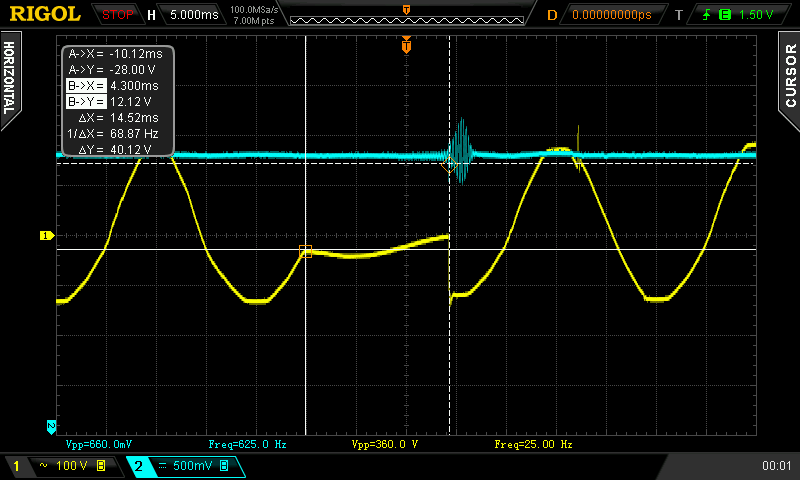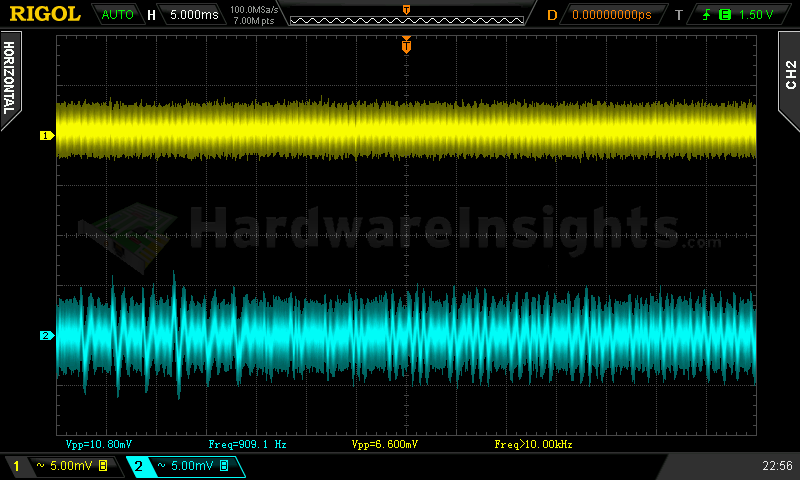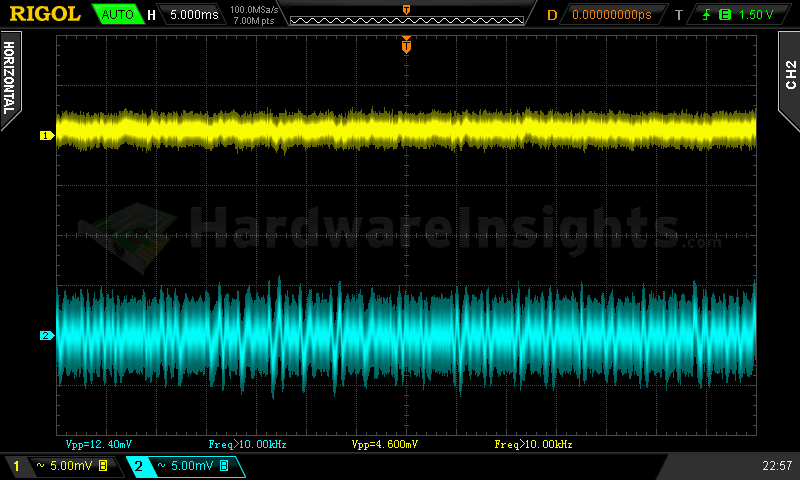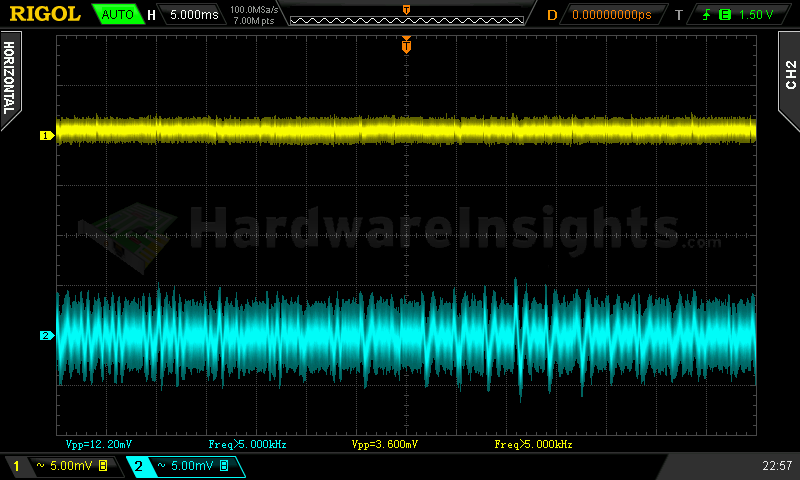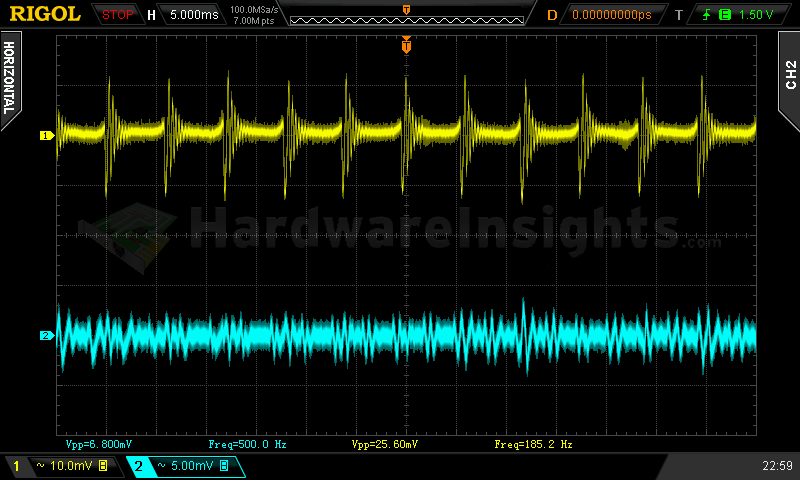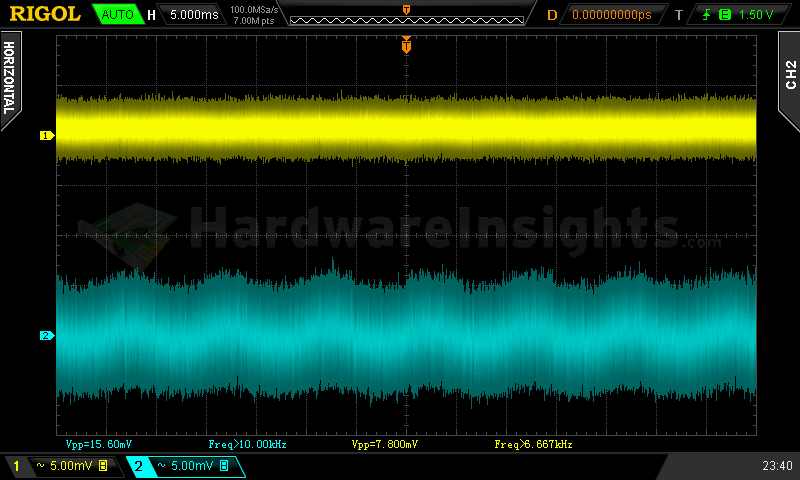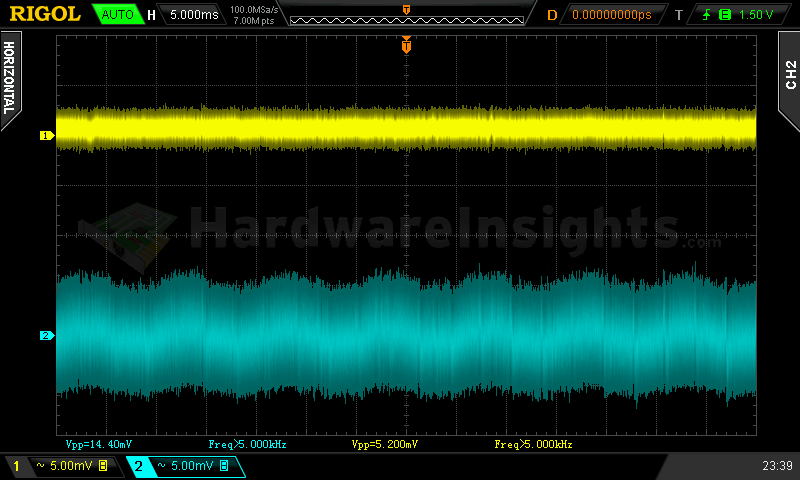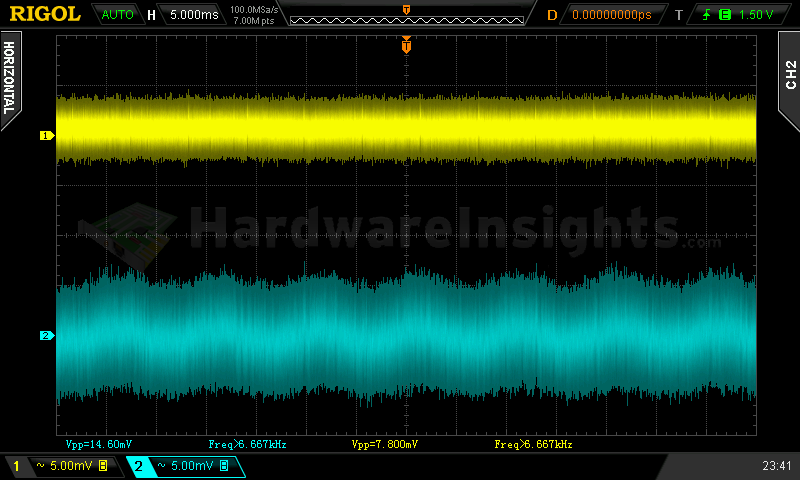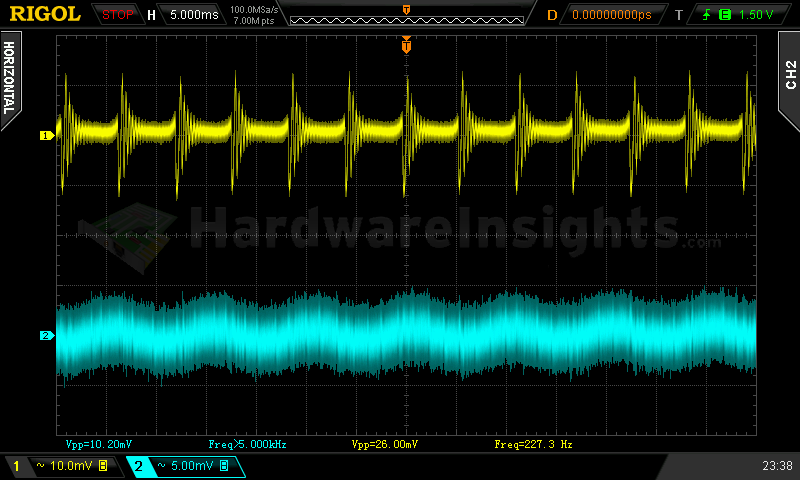Contents
- 1Introducing the Corsair SF600
- 1.1Packaging and accessories
- 2Connectors & cabling
- 2.1Casing & cooling
- 3Input filtering
- 4Primary side
- 4.1+5 V stand-by rail
- 5Secondary side
- 5.1Build quality
- 6Load testing
- 6.1Loading +5 V SB
- 6.2Hold-up time
- 6.3Combined loading
- 6.4Combined loading ripple
- 6.5Crossloading, overloading
- 6.6Crossloading, overloading ripple
- 6.7Fan speed, temperatures and noise
- 7Conclusion and evaluation
- 7.1Thanks
- 7.2Discussion
Load testing
Loading +5 V SB
As always, all load testing is performed per our testing methodology. The voltage regulation is very nice, as the SF600 maintains regulation within 1%, which is great result. The ripple is low while the efficiency is high above average. I think this would be worth an extra point.
| Output (W) | Load (A) | Voltage (V)/ ripple (mV) | Input (W) | Efficiency/power factor |
| 0 | 0 | 5.048/5.280 | 0 | —/0.001 |
| 12.25 | 2.44 | 5.021/5.520 | 15.73 | 77.9 %/0.443 |
| 17.18 | 3.43 | 5.010/6.320 | 22.25 | 77.2 %/0.489 |
+5 V SB ripple (left to right): 0 A; 2.44 A; 3.43 A
Hold-up time
As we can see on the oscilloscope screenshot, the hold-up time of the SF600 +12 V rail is relatively long at 20.90 ms. However, heavy oscillations appear just before the unit shuts down. Their peaks are high above 12.60 V which is in violation of ATX specification.
The hold-up time of the power good signal is shorter, at 16.68 ms, and there is also some oscillation though not as serious.
While interrupting the power for a given time, I found the +12V rail hardly noticed the drop, but the oscillation is still there. I had to further decrease the time to 14.52 ms so the peaks get into spec. Though it was still not 100% clean – upon few trials the peaks were sometimes still jumping over the rail maximum allowed voltage. This is not entirely OK so here the SF600 is going to first lose some points for not keeping with my high-end demands, and second minus 10 points for violating the spec here. I think it is not THAT serious problem as the input filtering in each VRM (on motherboard, VGA etc.) should catch it, but still, it is in violation of the spec. So as with the Silverstone Strider Titanium 600 W and its −12V rail regulation, a great loss in points is definitely a must.
Combined loading
Combined loading was quite good. Lets talk about the voltage regulation first. The Corsair SF600 does not break the habit of outstanding results of the unit we previously reviewed. All the rails kept their line regulation within 2 %, and the load regulation was just fantastic. If I am looking correctly, all the rails managed to keep it within 1 %. There is nothing I can comment, really.
| Output power | Load/ voltage +5 V SB | Load/ voltage +3.3 V | Load/ voltage +5 V | Load/ voltage +12 V | Load/ voltage −12 V | Input power | Efficiency/ power factor |
| 4.6 %/ 27.86 W | 0 A/ 5.041 V | 0 A/ 3.362 V | 0.317 A/ 5.043 V | 1.864 A/ 12.164 V | 0.301 A/ −11.934 V | 38.20 W | 72.9 %/ 0.722 |
| 20 %/ 130.44 W | 0.542 A/ 5.032 V | 1.478 A/ 3.357 V | 1.469 A/ 5.038 V | 9.18 A/ 12.160 V | 0.312 A/ −11.938 V | 147.2 W | 88.6 %/ 0.936 |
| 40 %/ 232.96 W | 1.037 A/ 5.023 V | 2.88 A/ 3.353 V | 2.11 A/ 5.035 V | 16.75 A/ 12.164 V | 0.312 A/ −11.941 V | 257.2 W | 90.6 %/ 0.936 |
| 60 %/ 360.67 W | 1.562 A/ 5.012 V | 4.09 A/ 3.346 V | 3.27 A/ 5.029 V | 26.2 A/ 12.173 V | 0.316 A/ 11.946 V | 401.0 W | 89.9 %/ 0.979 |
|
80 %/ 483.73 |
1.928 A/ 5.004 V | 5.50 A/ 3.339 V | 4.72 A/ 5.021 V | 35.2 A/ 12.167 V | 0.313 A/ −11.949 V | 540.2 W | 89.6 %/ 0.982 |
| 100 %/ 601.82 W | 2.26 A/ 4.994 V | 8.43 A/ 3.330 V | 7.71 A/ 5.013 V | 42.7 A/ 12.177 V | 0.322 A/ −11.956 V | 677.2 W | 88.9 %/ 0.986 |
As for the efficiency, the unit passes 80 PLUS Gold fine. The low-load efficiency is somewhat lower though, but not terrible either.
Combined loading ripple
The ripple values are also outstanding. Besides the −12V rail, everything was within 20 mV. On the lower-voltage rails it was also within 10 mV so I think it is worth an extra point.
| Output % | Ripple +5 V SB | Ripple +3.3 V | Ripple +5 V | Ripple +12 V | Ripple −12 V |
| 4.6 | 6.600 mV | 4.600 mV | 3.600 mV | 12.40 mV | 25.60 mV |
| 20 | 7.200 mV | 7.600 mV | 5.200 mV | 14.20 mV | 30.00 mV |
| 40 | 5.600 mV | 8.800 mV | 5.200 mV | 15.00 mV | 28.40 mV |
| 60 | 4.800 mV | 3.400 mV | 8.200 mV | 14.20 mV | 28.00 mV |
| 80 | 9.600 mV | 9.400 mV | 7.400 mV | 13.20 mV | 27.60 mV |
| 100 | 7.800 mV | 5.200 mV | 7.800 mV | 15.60 mV | 26.00 mV |
Ripple 4.6% load (left to right): +5 V SB; +3.3 V; +5 V; −12 V. The second channel is connected to +12 V.
Ripple 100% load (left to right): +5 V SB; +3.3 V; +5 V; −12 V. The second channel is connected to +12 V.
Crossloading, overloading
Crossloading tests went fine, as could be expected from such platform with DC-DC modules. The voltage regulation was pretty much the same as under combined loading tests, both line and load. The efficiency has dropped a bit but stayed at 80 % or more. As for the overloading, the unit did not react to any maximum load I put on different rails. So either the maximum is higher, or the OCP really is not implemented.
| Output power | Load/ voltage +5 V SB | Load/ voltage +3.3 V | Load/ voltage +5 V | Load/ voltage +12 V | Load/ voltage −12 V | Input power | Efficiency/ power factor |
| 16 %/ 98.26 W | 0.537 A/ 5.028 V | 20.21 A/ 3.352 V | 0.310 A/ 5.039 V | 1.888 A/ 12.171 V | 0.274 A/ −11.941 V | 122.8 W | 80.0 %/ 0.926 |
| 23 %/ 136.29 W | 0.553 A/ 5.026 V | 1.474 A/ 3.351 | 20.30 A/ 5.042 V | 1.848 A/ 12.176 V | 0.311 A/ −11.942 V | 161.9 W | 84.2 %/ 0.949 |
| 99 %/ 596.95 W | 0.537 A/ 5.020 V | 1.471 A/ 3.343 V | 0.266 A/ 5.026 V | 48.0 A/ 12.174 V | 0.305 A/ −11.949 V | 662.7 W | 90.1 %/ 0.986 |
| 140 %/ 841.35 W | 3.36 A/ 4.979 V | 1.445 A/ 3.331 V | 0.239 A/ 5.014 V | 66.9 A/ 12.183 V | 0.298 A/ −11.960 V | 920.0 W | 91.5 %/ 0.989 |
The OPP reacts fine though at slightly above 840 watts. That’s more than 140 % of rated power which is extraordinary result considering this is SFX unit! Two points for this. The unit still showed excellent regulation and also the efficiency was high as I was pulling almost all the power from the +12V rail.
Crossloading, overloading ripple
Here the ripple was similar to that of the combined loading set of tests though it increased slightly on the +5 V rail.
| Output % | Ripple +5 V SB | Ripple +3.3 V | Ripple +5 V | Ripple +12 V | Ripple −12 V |
| 16 | 5.000 mV | 6.200 mV | 10.00 mV | 8.400 mV | 27.20 mV |
| 23 | 6.400 mV | 4.800 mV | 10.40 mV | 12.40 mV | 30.00 mV |
| 99 | 4.400 mV | 6.400 mV | 10.40 mV | 12.80 mV | 24.40 mV |
| 140 | — | — | 5.800 mV | 12.00 mV | — |
Fan speed, temperatures and noise
The fan inside the Corsair SF600 started spinning not sooner than by the very end of test four, that is at more than 420 W output. So depending on your case cooling, the fan can start spinning much later than just at 120 W, that is as much as 300 W or even more. As I also discovered later while measuring the noise, at around 1000 RPM this is the minimum speed when the fan spins reliably. At this speed it is virtually noiseless (at 39.3 ambient – some CFLs were buzzing through the whole building this time!). At 1600 RPM it is already slightly audible though mildly. With higher load and higher speed, it gets noisy. So if you need silence while only accommodating SFX unit (not SFX-L), you will have to keep it under about 500 W. The overload tests showed the unit can cool itself down, but barely. It was running at full speed, at which it is clearly a helicopter, competing only with the Antec High Current Gamer M 750 W.
| Output % | Fan speed (RPM) | Temperature intake/ outtake | Noise (dBA) |
| 4.6 | – | 23 °C/ 23 °C | – |
| 20 | – | 26 °C/ 22 °C | – |
| 40 | – | 24 °C/ 21 °C | – |
| 60 | 1044 | 25 °C/ 48 °C | 39.3 |
| 80 | 1635 | 25 °C/ 41 °C | 39.6 |
| 100 | 2577 | 25 °C/ 45 °C | 44.4 |
| CL 16 | 1048 | 26 °C/ 37 °C | 39.3 |
| CL 22 | 1030 | 26 °C/ 41 °C | 39.3 |
| CL 98 | 2222 | 26 °C/ 48 °C | 41.4 |
| OL 122 | 3737 | 25 °C/ 51 °C | 51.2 |
Overall, the unit seems to be designed to operate at high temperatures so it can keep the fan speed down. With quality capacitors that is not really a problem, though it occurs the me the internal temperatures could still be somewhat lower than they are. Even according to Corsair’s own reports from GreatWall, it is really high at some components. This may be a problem especially in a case of too often start-ups of the unit when it will be under physical stress because of repeated thermal expansion. On the other hand, Corsair offers 7-year warranty so it’s really not your problem. The overheating tests showed the unit indeed is designed to run hot as it took 13 minutes and 22 seconds before the damn thing overheated enough to shut down with stuck fan! An SFX unit! That seems like three more extra points. It was quite hot though as the outcoming air had about 70 °C.
So it indeed is highly efficient and it really takes long to heat it up. That is also the reason while the fan started spinning so late at more than 400 W output. I think it is clear that Corsairs next generation of SFX units will bring 700W 80 PLUS Platinum model.
